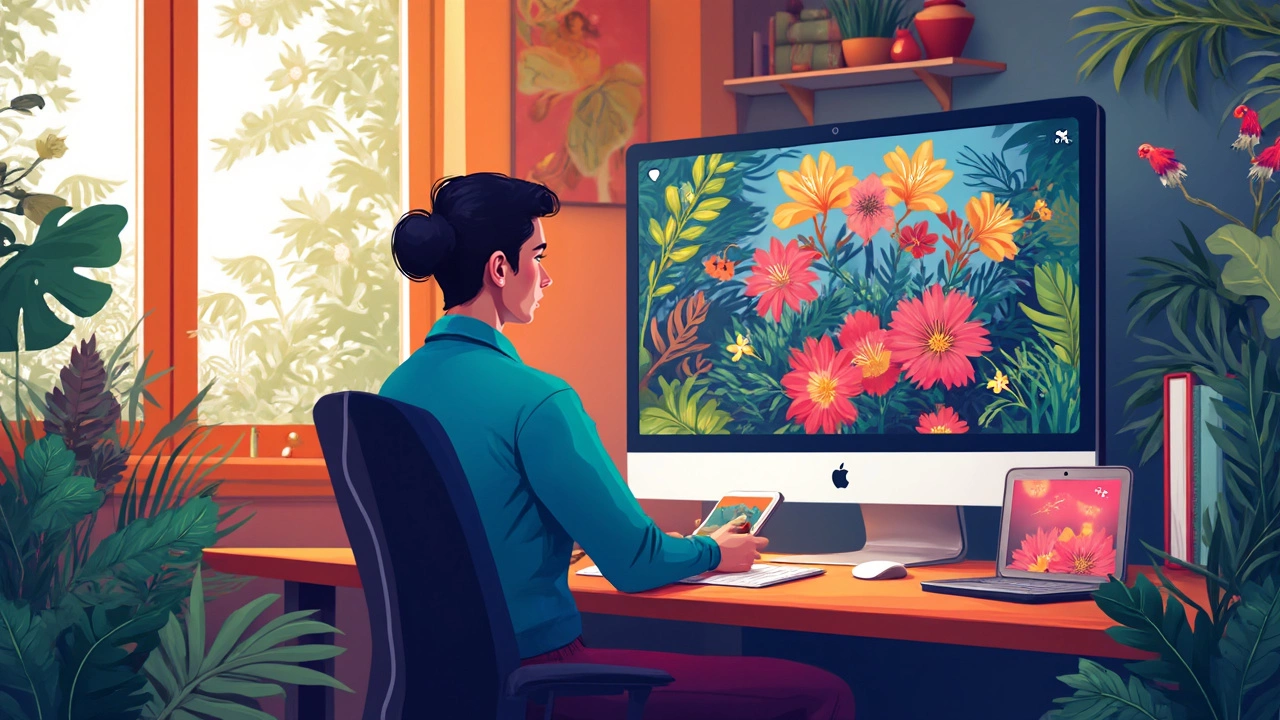Responsive design is more than just a buzzword—it's about making websites that adapt seamlessly to different screens and devices. With the explosion of smartphones, tablets, and laptops, having a site that works great everywhere is non-negotiable.
You ever open a site on your phone, and it's just a mess? Yeah, that's what we're avoiding here. Key to this magic is understanding how different design styles contribute to smooth, pleasant user experiences across all devices. Let's take a closer look at what makes up these styles, starting with the trusty fluid grids.
Fluid grids are like the skeleton of a responsive design—they help your layout scale in size depending on the screen it's viewed on, keeping everything looking just right. And it's not just about squishing everything smaller; it's about the whole layout flowing and shifting like it was built for that space specifically. Next up, pair those grids with flexible images and media that won't break your design when the screen size morphs. It's like your site's media becoming a shape-shifter!
- Understanding Responsive Design
- Fluid Grids: The Backbone
- Flexible Images and Media
- Media Queries and Breakpoints
- Tips for Effective Responsive Design
Understanding Responsive Design
Alright, so what's responsive design all about? Fundamentally, it's about making sure your website works on any device. We live in a world where people surf the web on everything from their 5-inch smartphone to their 65-inch TV. If your site can't adjust, you miss out big time.
Responsive web design is the practice of building sites that provide an optimal viewing experience across a wide range of devices. And there are some key components to making this happen.
Why It's Important
First off, the numbers don't lie. Around 50% of global web traffic now comes from mobile devices. So, if your site isn't mobile-friendly, you're potentially losing half of your audience.
Core Elements
The magic sauce? It’s stuff like fluid grids, flexible images, and media queries—fancy terms, but they're the bread and butter of making sure things look slick on any screen.
- Fluid Grids: Unlike fixed layouts that struggle with different screen sizes, these grids help layouts adjust smoothly. Think of it like a fluid that takes the shape of its container.
- Flexible Images: No more images breaking your whole site when you look on mobile. These adjust based on screen size while maintaining quality.
- Media Queries: These allow you to apply different CSS styles based on different device characteristics like width, height, or even orientation. They're the reason a site can look one way on mobile and another on desktop without a hitch.
Now, imagine checking a website and it looks perfect whether you're on your phone or flipping it sideways. That's a result of well-thought-out responsive design.
Fluid Grids: The Backbone
At the core of responsive design lies the concept of fluid grids. Think of them as the flexible framework holding your design together. Unlike fixed grids that are static and rigid, fluid grids adjust dynamically, keeping the layout consistent across various devices and screen sizes. This adaptability is crucial because, hey, it’s a multi-device world out there!
How Fluid Grids Work
Fluid grids use relative measurements like percentages instead of fixed units like pixels. This means that elements within a grid are sized in relation to one another rather than being tied to specific dimensions. Imagine your page layout as a set of Lego bricks that automatically reassemble to fit neatly into any space.
Here's a simple breakdown of how to create a fluid grid:
- Define a grid system: Decide on the number of columns, often 12, for maximum flexibility.
- Set column widths: Use percentages so columns can scale independently.
- Pay attention to margins and spacing: These should also use relative units to ensure everything scales harmoniously.
Boosting Design Efficiency With Fluid Grids
The great thing about fluid grids is their efficiency. When done right, they save a ton of time on design adjustments across different screens. Plus, they contribute to a sleek, unified web design that's user-friendly.
Fluid grids not only improve aesthetics but also enhance load times. Faster sites mean happier users, and in a world where attention spans are shorter than ever, that’s a big win! Fun fact: Faster-loading sites tend to rank higher in search engines, giving you a little SEO boost.
Embracing fluid grids doesn't mean you lose control over your design—quite the opposite. They give you the tools to make your site responsive and adaptable, keeping the user experience smooth and your brand looking sharp.

Flexible Images and Media
When it comes to responsive web design, making images and media flexible isn't just smart—it's a necessity. Why? Because nothing cramps the style of a sleek, responsive site like media that refuses to scale with it. If you've ever seen an oversized image breaking through parent containers on a small screen, you know the struggle.
So, what's the trick? Introduce yourself to the magic of the max-width: 100% rule. By applying this CSS property, your images and videos automatically resize to fit their container, preventing overflow and maintaining the visual integrity of your site. With the scaling in place, your responsive design maintains its charm across devices, from gigantic desktop screens to tiny smartphones.
Responsive Images
Let's get more precise. Whether you're working with JPEGs, PNGs, or SVGs, the idea is to keep them adaptable. Use the srcset attribute in your <img> tags to offer multiple image resolutions. This means as the screen size changes, the browser can pick the most suitable image file without extra work from you.
Embedding Responsive Videos
Videos are a bit more complicated than images, but here's a neat trick. Wrap your video in a <div> with a class of video-wrapper. Using a bit of CSS, you can make that wrapper resize nicely. Like a great pair of shoes, it fits perfectly no matter the occasion.
Media Queries for Media
And don't forget about media queries. These can adjust how your images and other media display based on screen size and orientation. That way, even your media's behavior changes, offering the best user experience no matter the viewer's device.
Media Queries and Breakpoints
In the world of responsive design, media queries are like hidden superheroes. They're part of CSS that helps your site know what kind of device is viewing the page, so it can style things appropriately. Think of them like a conversation your website has with different devices, asking, "Hey, are you on a phone, tablet, or desktop?" This dialogue lets your site adjust its layout, size, and look to fit the user's device perfectly.
Media queries use what's known as "breakpoints." These are specific screen widths where the styling has to change to optimize everything from typography to the layout itself. It's like deciding that once the screen width dips below a certain point, it's time to rearrange the furniture.
Common Breakpoints
While there's no one-size-fits-all set of breakpoints, here's a list that many designers often use:
- 320px for small mobile devices
- 768px for tablets
- 1024px for portrait tablets and small desktops
- 1280px and up for large desktops
These aren't rules engraved in stone, but they give you a solid starting point. It's crucial to test your site at various widths to see what's looking smooth and what's not, adjusting your breakpoints accordingly.
Using Media Queries Effectively
When you're diving into media queries, keep these tips in mind:
- Keep it Minimal: Use as few media queries as you can while still getting the job done. Too many can slow down your web design process and make your CSS overly complex.
- Design Mobile-First: Start by designing for the smallest screen and build up. This helps you prioritize the most important elements since you have limited space initially.
- Test, Test, Test: Check your site across different devices and screen sizes. Remember that user experience is king!
| Device Type | Common Width |
|---|---|
| Smartphone (portrait) | 320px - 480px |
| Tablet | 768px |
| Desktop | 1024px and up |
Understanding how to properly wield media queries and set effective breakpoints is a cornerstone of responsive web design. Master it, and you're well on your way to creating sites that feel perfectly tailored, no matter what device they're viewed on.

Tips for Effective Responsive Design
So, you're diving into making your site look good everywhere? Awesome! Here are some solid tips to get you started on creating a responsive design that works wonders.
1. Prioritize Mobile-First Approach
Kick off your design process by focusing on mobile users first. More people browse on their phones these days, so start small, then scale up. This ensures the most critical features are accessible and functional.
2. Use Media Queries Wisely
Media queries are your best friend when designing for different devices. They let you apply specific styles to certain screen sizes. It's like giving your design the ability to dress appropriately for the occasion!
- Start by setting breakpoints where the design looks funky.
- Keep CSS applicable to broader ranges rather than an ultra-customized mess for each device.
3. Adopt a Flexible Grid Layout
Make sure you're using grid layouts that are fluid. Fixed widths are so last decade. Instead, let those grids adjust using percentage-based widths.
4. Optimize Images
Don't let large images slow down your site. Use flexible images that resize based on the screen size or take advantage of the Responsive Images syntax (<picture> and <img <srcset>).
5. Test on Real Devices
Nothing beats real-world testing. Simulators are cool, but phones and tablets in your hands tell the truth about responsive styles and functionality. Encourage feedback to improve any overlooked pain points.
6. Utilize Tools and Frameworks
Don't shy away from frameworks like Bootstrap or Foundation. They provide components that are pre-styled for responsiveness, so you're not reinventing the wheel.
There's a lot of ground to cover in responsive web design, but these tips will have you navigating it like a pro. With some practice, you'll fine-tune the aesthetics and functionality to keep users swiping and clicking happily.


